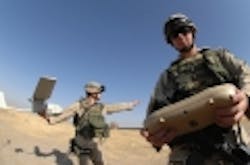Software-defined radio achieves popularity outside of JTRS military radio program
PHOENIX, 23 Sept. 2010. While the Joint Tactical Radio System (JTRS) program fueled the development of software-defined radio (SDR), it has moved into other military areas and into the commercial world with companies such as ZTE in Shenzhen, China are shipping large numbers of SDR products, says Lee Pucker, chief executive officer of The Wireless Innovation Forum in Phoenix.
SDR systems are also found in other U.S. military programs and in Europe too, Pucker continues. For example Harris RF in Rochester, N.Y., has been successful with their Falcon III line of software-defined radios and Rockwell Collins in Cedar Rapids, Iowa, and Thales in Neuilly-sur-Seine, France are developing their FlexNet radios for European applications.
The Harris Falcon III AN/PRC-117G, which is a wideband tactical radio that is both compliant with the JTRS Software Communications Architecture and NSA Type-1 certified, Harris officials say. The radio has been deployed by the U.S. Army and other services to mission areas.
The FlexNet radios are based on multi-band and multi-channel communication systems, designed with an open and secure architecture, compliant with the SCA standard, and will accommodate future technology insertions and capability upgrades, according to a Rockwell Collins release. End users can develop and download their own waveforms into the radio.
The FlexNet device has been selected for European applications, most recently by Swedish FMV for FlexNet-Four SDRs to support the country’s Tactical Data Radio System (TDRS) program for advanced ground mobile communications, according to a Rockwell Collins release. The FlexNet platform has been selected by the European Secure software-defined Radio (ESSOR) program to support the new European Coalition Waveform.
“The FlexNet-Four radio provides the TDRS with the ability to handle larger networks while providing the Swedish Armed Forces with mobile wireless networking in a self-contained communications system,” says Bruce King, vice president and general manager of Surface Solutions for Rockwell Collins, in the release. “The FlexNet-Four embraces the same objectives envisioned by the U.S. Joint Tactical Radio System program and supports real-time network centric operations and enhanced interoperability.”
An SDR’s open architecture also makes the devices cost-efficient by using an open architecture design that enables technology refresh.
